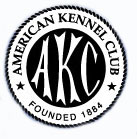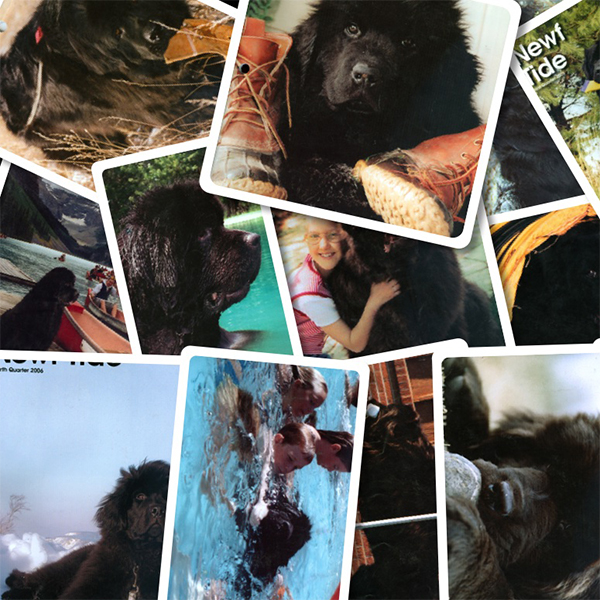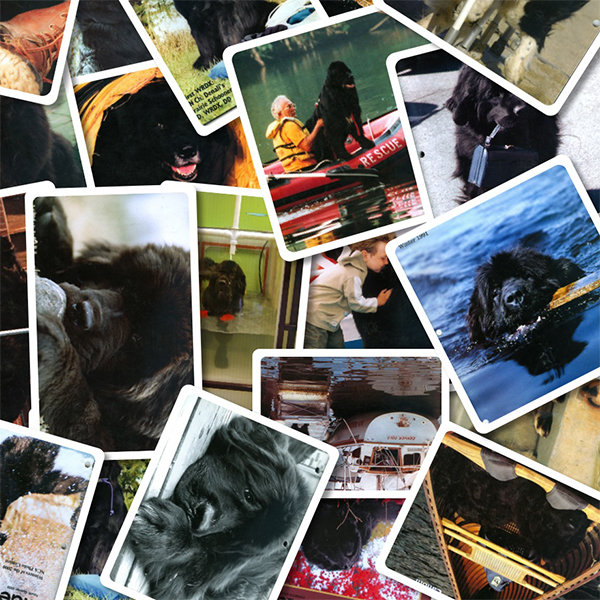
By now, you are surely as tired as I am of hearing about Y2K. But this does seem to be the proper time to stop and think about where our breed has been and what the future holds for it.
It was about a 1,000 years ago that the Vikings made landfall on the shores of Newfoundland and Labrador. Though we may never know for sure whether Leif Ericson’s Oolum was the pregenitor of the Newfoundland dog, there were known to be large domesticated dogs utilized by man at that time. Through natural selection, mutation, and the hand of man over many years, Newfoundland dogs evolved to become the breed we know today. In the 1500’s and 1600’s fishermen, hunters, and lumberjacks living in Newfoundland used dogs in their work. These dogs were selected for the strength of their bone structure and for working ability, intelligence and docility. The color of the coat or the curve of its tail was not important. During the 1700’s, these large, docile animals were sought after more and more, and some were imported to England and other European countries. This was indeed fortunate, as several governmental decrees issued over the years dramatically reduced the number of dogs in Newfoundland.
The late 1700’s and the 1800’s saw the breed becoming more standardized. The many coat colors and patterns formerly seen were reduced to black, bronze, and gray. Sir Edwin Landseer, the famous English painter, popularized the white and black Newfoundland that was nicknamed the Landseer Newfoundland. (This was different from the continental-type Landseer, which the FCI recognizes as a separate breed). The breed’s characteristics of large size, heavy substance and bone, swimming and working abilities, and benevolent, intelligent manner were set.
The 1900’s saw the Newfoundland as we know the breed today. We have tweaked some things; some would say we have made the Newf a “prettier” dog. But, for the most part, the Newf of today retains its historic attributes. Will we be able to say the same things as we proceed into the new millennium?
Will the Newfoundland retain its swimming ability if we breed for an open coat or one that is too long or too thick? Will the Newf be able to pull heavy loads safely if his rear angulation becomes too extreme? Will he retain the soft, benevolent manner that has endeared him to thousands of fanciers if we keep breeding for a more “up” attitude in the show ring? Time will tell, won’t it?
What will owning the Newfoundland dog be like in a few hundred or even a thousand years? Scary thought, isn’t it?
On one hand, we are close to uncovering many of the genetic mysteries that have plagued breeders from the very beginning. Genetic testing is just around the corner, and with it the hope that sub-aortic stenosis, hip dysplasia and other orthopedic problems, PRA, and so on will soon be faint memories. Certain medical conditions that are now untreatable will be highly curable in the future, if they exist at all. In the ideal future, our furry friends will have long lives free from genetic disorders. DNA analysis and identification will be done on every AKC - registered dog. The AKC Stud Book will be able to verify each puppy’s parents.
Think of the possible advances in canine nutrition and in veterinary care. Maybe we will determine the exact, optimum level of nutrition for each stage in a dog’s life. Could it be that someday when we take our Newfie to the animal hospital for an exam, the vet will simply pass a “Star Trek - type” device over our dog’s body for a quick, accurate diagnosis? Don’t laugh - it could come to pass!
On the other hand, with all these advances come some problems. With cloning already a reality in the laboratory, how are we going to handle the implications of this technology for the whelping box and the show ring? Every breeder strives to produce the “perfect” or ideal dog. What happens if, by manipulating genes, we can reproduce our “perfect” dog consistently? What happens if the challenge to produce that perfect dog no longer exists? Are we, as breeders and exhibitors, mature or intelligent enough to handle this responsibility wisely?
What will the future bring? I really have no idea. My crystal ball has proven to be unpredictable. All I know is that I’m looking forward to spending many more years with my Newfies! The Newfoundland Club of New England will host this year’s national specialty on May 2 to 6 at the Crowne Plaza at the Crossing in Warwick, RI.

